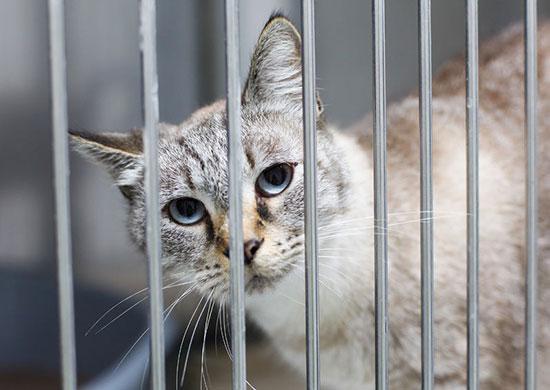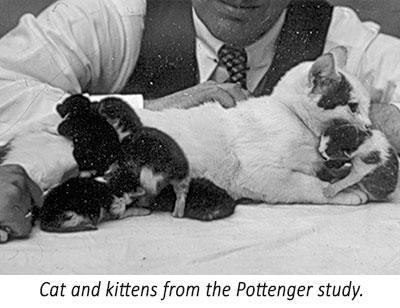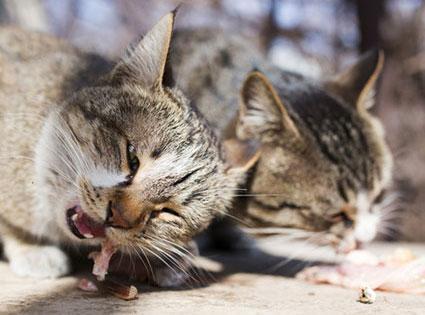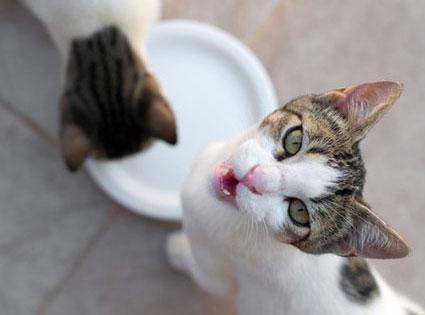This content is archived from the Feline Nutrition Foundation
Answers: Who Were Pottenger's Cats and Do They Matter?
- Updated: Sunday, June 02, 2019 02:45 PM
- Published: Monday, September 04, 2017 03:21 PM
- Written by Guillermo Díaz. MV
 I am new to the idea of feeding raw food to cats, so I have been trying to learn as much as I can on the subject. I have seen references to a study done a long time ago by a Dr Pottenger on raw cat food. Is this study still useful?
I am new to the idea of feeding raw food to cats, so I have been trying to learn as much as I can on the subject. I have seen references to a study done a long time ago by a Dr Pottenger on raw cat food. Is this study still useful?
If you are reading up on raw food for cats, at some point the name Pottenger will come up. The Pottenger studies done in the 1930s are sometimes cited as proof that a raw cat food diet is superior to a cooked meat diet. In this article, I will explain the basic studies Dr Pottenger did and discuss whether they are relevant to feeding cats raw food today.
Doctor Francis Marion Pottenger Jr. was a doctor of human medicine who was concerned about heat-labile nutrients in food that were available in the raw form, but were then destroyed by heat when the food was cooked. He conducted a multi-generation nutrition study between 1932 and 1942, to determine the effects of heat-processed food on 900 cats.¹ The study shows the effects of consuming denatured foods and describes in detail all of the physical and emotional problems which developed in the cooked diet fed animals that never occurred in those eating the raw cat food. The cooked diet cats never even got past the third generation, since they lost fertility and the ability to reproduce.
 Originally, Dr. Pottenger had the cats because he used them in his studies to help human patients. The cats had their adrenal glands removed as part of his research. Otherwise, they were healthy and well cared for. They were fed cooked meat scraps which included internal organ meats and bones along with some additional raw milk and cod liver oil. This diet provided what at the time was considered an optimal amount of nutrients and the cats seemed healthy. Nevertheless, they had an unexplainably high mortality rate. Then, due to a change in the number of cats in the study, raw meat scraps replaced the cooked meat in the diet of certain cats. Within a short period of time, the mortality rate dropped significantly. The cats eating raw meat began to have much better survival rates and superior quality of health. Pottenger then began ordering raw meat scraps from a local meat packing plant – including organs, meat and bones – and fed a separate group from this supply. Within months, this group appeared in better shape than the cooked meat group and their offspring were healthier. Pottenger was intrigued by what he termed "heat-label factors" and asked himself if the cooking process somehow rendered food nutritionally deficient, causing eventual physiological degeneration.
Originally, Dr. Pottenger had the cats because he used them in his studies to help human patients. The cats had their adrenal glands removed as part of his research. Otherwise, they were healthy and well cared for. They were fed cooked meat scraps which included internal organ meats and bones along with some additional raw milk and cod liver oil. This diet provided what at the time was considered an optimal amount of nutrients and the cats seemed healthy. Nevertheless, they had an unexplainably high mortality rate. Then, due to a change in the number of cats in the study, raw meat scraps replaced the cooked meat in the diet of certain cats. Within a short period of time, the mortality rate dropped significantly. The cats eating raw meat began to have much better survival rates and superior quality of health. Pottenger then began ordering raw meat scraps from a local meat packing plant – including organs, meat and bones – and fed a separate group from this supply. Within months, this group appeared in better shape than the cooked meat group and their offspring were healthier. Pottenger was intrigued by what he termed "heat-label factors" and asked himself if the cooking process somehow rendered food nutritionally deficient, causing eventual physiological degeneration.
He decided to begin a controlled scientific study that can be divided into two parts: the meat study and the milk study. For the purpose of the study, the animals were divided into different groups that were fed either cooked or raw animal-based foods. This consisted of cooked meat versus raw meat, and pasteurized dairy versus raw dairy. The cats chosen for the study were kept in open air pens with a yard four feet wide, seven feet high and twelve feet long.
Meat Study
Pottenger divided this study into two groups. In Group A, the cats were fed a diet of 2/3 raw meat, 1/3 raw milk and cod-liver oil. In Group B, they were fed a diet of 2/3 cooked meat, 1/3 raw milk and cod-liver oil.
 The subjects fed the raw diet were healthy, while those fed the cooked-meat diet developed various health problems. By the end of the first generation, the cooked-meat cats started to develop degenerative diseases and became quite sedentary. By the end of the second generation, they had developed degenerative diseases, changes in their skeletal structure were evident and the calcium content of their bones had fallen to ten percent. At sixteen weeks of age, the second generation raw food kittens weighed 2000 grams average, while the second generation cooked-meat animals only weighed about 1600 grams.
The subjects fed the raw diet were healthy, while those fed the cooked-meat diet developed various health problems. By the end of the first generation, the cooked-meat cats started to develop degenerative diseases and became quite sedentary. By the end of the second generation, they had developed degenerative diseases, changes in their skeletal structure were evident and the calcium content of their bones had fallen to ten percent. At sixteen weeks of age, the second generation raw food kittens weighed 2000 grams average, while the second generation cooked-meat animals only weighed about 1600 grams.
By the end of the third generation, the cooked-meat subjects had developed degenerative diseases very early in life and some were born blind and weak with a much shorter life span. Many of the third generation couldn't reproduce. Most of these adults were void of interest in sex and those that attempted to mate could only produce stillborn litters. Kittens of the third generation did not survive six months. The cats died out totally by the fourth generation. Skin diseases and allergies increased from an incidence of five percent in normal cats to over 90 percent in the third generation of deficient animals. The fur of the deficient cats lost its sheen and shedding was noticeable. Males became docile while females became more aggressive. The skull was considerably smaller, flat with pointed features and the bones were paper thin and soft like sponge rubber. The calcium content of the bone had fallen to a low three percent by weight. On the other hand, the raw food subjects continued to reproduce healthy offspring generation after generation.
Milk Study
In this study, the cats were fed 2/3 milk and 1/3 meat. All groups were fed raw meat with different groups getting raw, pasteurized, evaporated or sweetened condensed milk.
The raw milk cats were the healthiest; they moved about the pen with a great agility and coordination. Their fur was shiny and soft and they presented normal sexual interest. They would land on their feet when thrown in the air.
 Those not being fed raw milk exhibited varying degrees of health problems similar to the previous cooked meat study.
Those not being fed raw milk exhibited varying degrees of health problems similar to the previous cooked meat study.
The pasteurized milk cats moved about the pen in a manner quite different from those that received raw milk. Some developed arthritis, skeletal changes and lessened reproductive efficiency. Lethargy was present in all, with no apparent energy. Their offspring presented progressive constitutional and respiratory problems. These animals exhibited an impaired sense of coordination when thrown a short distance. Dental deterioration, abscesses and gingiva inflammation were a frequent finding. All of these changes were similar to the cats of the first, second and third generations eating cooked meat.
The evaporated milk cats showed even greater deterioration than their pasteurized milk counterparts with the most marked deficiencies occurring amongst those fed sweetened condensed milk.
The sweetened condensed milk group not only had their milk heat-processed, but there was the addition of sugar. There was marked deterioration in coordination and dental abnormalities. They developed much heavier fat deposits and exhibited severe skeletal deformities and were prone to bone fractures. They were nervous animals showing extreme irritability and often paced back and forth in their pens.
Discussion
Any newcomer to the topic of cat nutrition who has just encountered the Pottenger study should be aware that all of the above is a brief summary of the ten years of research on the effect of cooked food on the health of cats. This was remarkable research for its time, but we have to keep in mind that this experiment was done 70 – 80 years ago. At that time, it was unknown how specific nutrients affected the health of the cats. Now, we know more. Taking advantage of technology and the updated information we have, we are able to point to certain flaws in the study.
There were no good scientific controls. All of the cats were donated and Dr. Pottenger didn't know the thorough history of each one. Most of them were strays, which can lead to statistical errors. Concerning the food, the composition of the diet was not constant during the ten-year period. Because of its origin, it varied in freshness and quality.
This study was done many years before the role of taurine was very well understood. Lack of taurine can produce the same signs and degenerations noted in the experiment by Pottenger, who couldn't explain these deficiencies in terms of lack of this vital nutrient. Many of the problems the cats showed could be attributed to taurine deficiency.
The fact that the cooked diets in the experiment were deficient demonstrates that the cooking process affects the natural nutrients in the meat and hence it's biological value. For water-soluble nutrients such as taurine, simply removing the liquid content of the meat through cooking drastically reduces the meat's taurine content. In commercial cooked foods, dry and canned, these nutrients need to be artificially added back in. At this point we have to ask ourselves, why feed a diet where you have so altered the naturally-occurring nutrients?
Additional Reading
Adding Taurine to a Raw Cat Food Diet
It's not the author's intention to debunk in any way this remarkable study, which was ahead of its time, but rather to emphasize Dr. Pottenger's great skill as a scientist. He knew or suspected that the symptoms he observed were those of a nutrient deficiency of some sort, even if he could not identify taurine. That's quite an achievement for its time.
Note: Feline Nutrition provides feline health and nutrition information as a public service. Diagnosis and treatment of specific conditions should always be in consultation with your own veterinarian. Feline Nutrition disclaims all warranties and liability related to the veterinary advice and information provided on this site.
Dr. Guillermo Díaz and family, including their four dogs (Leroy, Xica, Moza and Pepa) and six cats (Michalina, Tigger, Vladimir, Yellow, Mongo and Chirusa) moved to Buenos Aires, Argentina in July of 2017, where he expects to continue supporting different animal rescue groups, spread the benefits of raw food for cats and dogs and write articles about nutrition.
1. FM Pottenger, Pottenger's Cats, A Study in Nutrition, 2nd ed. Price Pottenger Nutrition, June 1, 2012.




